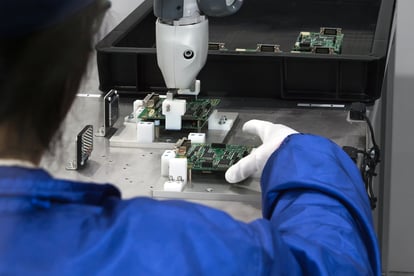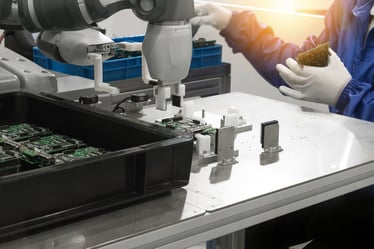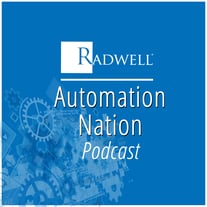 Articles about automation in manufacturing, particularly robotics and collaborative robots, sometimes called “cobots,” appear frequently in the press. The headline message often is focused on eliminating jobs and replacing workers.
Articles about automation in manufacturing, particularly robotics and collaborative robots, sometimes called “cobots,” appear frequently in the press. The headline message often is focused on eliminating jobs and replacing workers.
Every time I hear someone mention that automation is replacing people, I start to fidget as I prepare for a debate. In Minnesota, we sometimes call this the “yeah-buttal.”
We seem to have long forgotten that computers with spreadsheet, word processing and presentation software have replaced slide-rules, calculators, typewriters, transparency film and so on, as well as stenographers and others who used these low-tech tools. Thankfully. Of course, we use the computers, and we are much more productive. The combination of computer software and hardware might be considered a form of automation (as well as communication, entertainment and a host of other functions), and society has accepted this.
Manufacturing is different
The dynamic is different in manufacturing automation where there are still humans engaged in direct labor on the factory floor — or at least on many of them — and to the degree that automation may enable the elimination of jobs, automation is sometimes viewed as a threat. We’ve all heard stories of sabotage by disgruntled employees in automotive plants and the like, although such instances were likely overstated. The source of disgruntlement may or may not have been the machine — it was just an innocent victim.
What is the purpose of automation? Is its goal to replace people? Consider the data. According to the Federal Reserve Economic Data (FRED), the U.S. Industrial Production Index shows a continual rise in industrial production since the 1920s, notwithstanding the temporary recessionary blips in years such as 2009. Also, according to the Fed, U.S. manufacturing employment peaked around 1979 at nearly 20 million people, but since then has dropped to only a little more than 12 million in 2017. Again, according to FRED, production output per employee has literally doubled since 1990. The scenario portrayed above is clear: U.S. manufacturers are producing more output with fewer workers. Depending on your perspective, that may not sound good. It may sound like a lot of unemployed folks. However, if all those people simply became unemployed, then the unemployment rate should have risen accordingly, and dramatically. Instead, the U.S. seasonally adjusted employment rates of 6% to 8% in the late 1970s have dropped to around 4% just prior to the recent COVID-19 period. So, yes, automation (and other factors) have enabled much higher levels of production output with fewer people, and I readily admit that reducing labor costs is indeed one of the goals.
The scenario portrayed above is clear: U.S. manufacturers are producing more output with fewer workers. Depending on your perspective, that may not sound good. It may sound like a lot of unemployed folks. However, if all those people simply became unemployed, then the unemployment rate should have risen accordingly, and dramatically. Instead, the U.S. seasonally adjusted employment rates of 6% to 8% in the late 1970s have dropped to around 4% just prior to the recent COVID-19 period. So, yes, automation (and other factors) have enabled much higher levels of production output with fewer people, and I readily admit that reducing labor costs is indeed one of the goals.
Automation’s higher purpose
Ironically, however, in all my years of working in the automation industry, I’ve rarely felt as if the sole or even primary purpose of such investment was to eliminate jobs. More often, the higher purpose was to increase output, improve safety or improve quality and precision. Consider a canning line running at 1,800 cans per minute. Only an automated filling line could accomplish such a thing. Envision a stamping press that, without proper controls, could easily sever the operator’s hands or take a life. Think about the sanitary and precision requirements of medical device production or semiconductor fabrication. Many of these processes are only possible with automation.
Most manufacturing firms, and even entire industries, today can exist only if they automate; and for those of us in the automation industry, that gives us a great sense of purpose. We help our customers do what they do, make what they make, to stay in business and often it is the only way they can continue to operate here in the United States. By contrast, for some time China was viewed as not being as highly automated due to lower labor costs. But since 2013, China has been the largest robot market in the world due to all the reasons above — it’s not just about reducing labor.
In the most general sense, automation is machinery. Computerized numeric controls (CNCs) for machining; packaging machines for food, beverage or other consumer goods; conveyors for moving product from one station to the next — just look around at every object in sight that was manufactured somewhere — your windows, your computer and all its components, your eyeglasses, your flooring, your credit cards, are possible due to some level of automated machinery — even your car is a machine that replaced a horse, and I don’t hear anyone complaining about that.
Robots as poster child
However, a certain form of automation is frequently the poster child for those who want to focus not on the merits and necessity of automation, but on the resulting efficiency and productivity from automation of manual processes, and elimination of jobs: the robot. Robots are not new. The earliest invention of what could be considered a robot was by George Devol of Louisville, KY, in the 1950s. He called the invention “Unimate,” short for “universal automation.” It was considered “universal,” because, unlike most machines that had a specific purpose, the Unimate could be outfitted and programmed to do many different jobs (although a far cry from truly “universal”). Devol was not successful commercially, but Joseph Engleberger purchased the patent in the 1960s and ultimately succeeded in deploying many robots under the brand “Unimation.” Since then, of course, many other firms globally have launched many other models, usually recognizable mostly due to their brand’s prominent signature color — often bright yellow, orange, blue or so on. These robots have been used increasingly along with machinery in all sorts of factories.
Robots are not new. The earliest invention of what could be considered a robot was by George Devol of Louisville, KY, in the 1950s. He called the invention “Unimate,” short for “universal automation.” It was considered “universal,” because, unlike most machines that had a specific purpose, the Unimate could be outfitted and programmed to do many different jobs (although a far cry from truly “universal”). Devol was not successful commercially, but Joseph Engleberger purchased the patent in the 1960s and ultimately succeeded in deploying many robots under the brand “Unimation.” Since then, of course, many other firms globally have launched many other models, usually recognizable mostly due to their brand’s prominent signature color — often bright yellow, orange, blue or so on. These robots have been used increasingly along with machinery in all sorts of factories.
By the way, we’re focusing here on industrial robots, those used in manufacturing, but we’re also seeing robotic inventions in completely different contexts such as in vacuuming your floor. That’s another discussion entirely, although it’s probable that such proliferation will drive a higher level of societal acceptance of the poor, beleaguered robot.
Why is the robot so often the target of such misguided criticism? Well, it has arms. Actually, it typically has just one arm, and in the industry is even sometimes simply called an “arm.” A robot arm is faster, more precise and usually stronger than a human arm (see Figure 1). It never gets tired, needs a bathroom break or calls in sick. It is programmed to do a specific, repetitive task, and typically requires little maintenance.
Unfortunately, unlike a human, a robotic arm does not have eyes, although certain television shows and sci-fi movies did feature such human-like mechanical creatures, with legs even. (By way of disclosure, many robots do use vision guidance, although such hardware doesn’t attempt to mimic the appearance of a human, except for one misguided firm who actually marketed a robot with eyes on a display screen — they even blinked.)
A real robot arm is typically fixed-mounted, either on the floor or on a pedestal or table, and programmed to follow a specific path — often quite rapidly and with a lot of mass driven by powerful servo motors, so you do not want to get in its way. Sometimes, such as in welding applications, the arm isn’t necessarily moving rapidly, but the operation itself is hazardous, so one would not want to be too close in these cases. For these and other reasons, the area in which the robot operates must be protected from human access while it is operating, and there are plenty of standards mandating this. Sometimes, the guarding is like a cage around just the robot and its operation, called a “robot cell.” Other times, as with spot-welding robots on an automotive assembly line, an entire area containing several robots working in concert is guarded to keep people out, and the line will cease to operate if a door to the area is opened, or if a scanner detects something/someone in the area that shouldn’t be there.
Enter, collaborative robots
Until this past decade, industrial robots were guarded. But then came along the collaborative robot. The essence of the term collaborative means that it can collaborate or operate in collaboration with humans. How can this be, and how is it not dangerous? The robot design is such that it is limited in power and force, including a feature that stops the robot instantly if a collision is detected, which can be accomplished several different ways. In many applications, the robot can be deployed without guarding it. A risk assessment always should be performed, which still sometimes results in the application being guarded, even though the robot is a “cobot.” An example would be if the robot is moving a sharp or protruding part that could cause injury, even with the slightest collision.
The term collaborative also can have a secondary meaning relating to the way it is trained. Rather than purely by entering speed and coordinates via a keyboard or pendant, they often may be trained by moving from point A to point B with the human hand, a nice collaboration of human and machine. Although the ease of programming is not the primary value proposition of a collaborative robot, it is often a very compelling advantage that has helped to sell many such arms.
Will cobots eliminate jobs?
Let’s return to the question of whether a collaborative robot can eliminate jobs and whether the dynamic is different than any other form of automation. We’ve already indicated that direct labor reduction is one of several goals of automation in general, and the data shows increasing industrial output over the years, while  manufacturing employment has dropped in the same period. While I’m certainly a proponent of automation in general, I would posit that the collaborative robot is especially suited to reducing the number of people on the factory floor in a one-by-one basis — remove a person, replace with a robot. Why? If an employee is performing a repetitive task for many hours a day, it often is relatively easy to implement a collaborative robot in his or her place in a relatively short time frame due to the ease of programming and setup, and without all the guarding required by traditional robots. For these same reasons, the collaborative robot also is much more affordable (not just the cost of the robot, but the installed cost, which avoids much of the engineering time and “robot cell” hardware) and therefore more easily justified financially, so it simply follows that more of them are likely to be deployed.
manufacturing employment has dropped in the same period. While I’m certainly a proponent of automation in general, I would posit that the collaborative robot is especially suited to reducing the number of people on the factory floor in a one-by-one basis — remove a person, replace with a robot. Why? If an employee is performing a repetitive task for many hours a day, it often is relatively easy to implement a collaborative robot in his or her place in a relatively short time frame due to the ease of programming and setup, and without all the guarding required by traditional robots. For these same reasons, the collaborative robot also is much more affordable (not just the cost of the robot, but the installed cost, which avoids much of the engineering time and “robot cell” hardware) and therefore more easily justified financially, so it simply follows that more of them are likely to be deployed.
To be clear, we say it often is relatively easy to deploy a cobot, but certainly there are many applications where deployment of any kind of automation is challenging. Notable examples are where the product being manufactured or processed is either difficult to handle or is not very repeatable such as in clothing, where so much of its production has continued to move around the globe in search of the absolute lowest labor cost, or in meat processing, which (as of this writing) is often in the news due to COVID-19 outbreaks. The core reason for such outbreaks is the large number of workers, employed near each other as they perform their butchering duties on an irregular and complex “product.” There will likely be some success in increasing automation in these facilities — certainly, the motivation is there, but to date, such achievements have been elusive.
A final point about using collaborative robots to reduce human labor — perhaps the best examples of successful deployment are in production facilities where there are multiple stations performing the same type of process such as in a machining facility with multiple CNC machines. Consider a facility with 30 CNC machines cranking out automotive components (see Figures 2 and 3). Without robotics, you may need 20 employees to tend all the machines (keeping a supply of blanks, placing the blanks into the CNC and then pulling them out afterward). With cobots deployed on the CNCs, or at least most of them, the operation may require only 5 to 10 operators — a meaningful reduction in labor — and as a bonus, a safer operation from the social distancing standpoint.
Looking ahead
It’s important to note that the employees mentioned above need to be more highly trained to operate collaboratively with the robots, and just as important, it’s necessary to employ or contract with someone who knows how to program and install the robots. Fewer people are indeed required, but they are generally better trained and more highly compensated. Manufacturing is once again a great place to build a career. What beautiful irony — reducing labor expenses with more highly paid employees.
To learn more about Radwell International
For a behind the scenes look at Radwell
To Listen to Radwell's Podcast, search Radwell Automation Nation
wherever you listen to your favorite podcasts
View the original article and related content on Control Engineering
https://www.plantengineering.com/articles/do-cobots-replace-people-in-manufacturing/
View the original article and related content on Control Engineering



